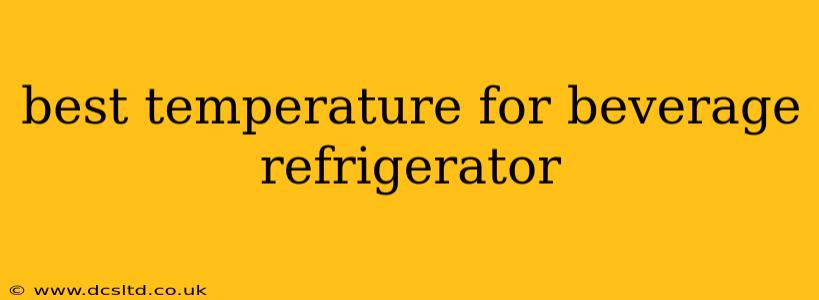Maintaining the optimal temperature in your beverage refrigerator is crucial for preserving the quality and taste of your drinks. Whether you're storing fine wines, craft beers, or refreshing sodas, understanding the ideal temperature range ensures your beverages are at their best. This guide explores the ideal temperature settings, factors influencing temperature choices, and troubleshooting tips to keep your drinks perfectly chilled.
What is the ideal temperature for a beverage refrigerator?
The best temperature for a beverage refrigerator depends on the type of beverage you're storing. However, a general guideline is to keep the temperature between 35°F and 40°F (1.7°C and 4.4°C). This range is suitable for most beverages and helps prevent spoilage and maintain optimal flavor profiles.
What temperature should I store beer in a beverage refrigerator?
For beer, the ideal temperature range is slightly broader, typically between 35°F and 45°F (1.7°C and 7.2°C). Lighter beers, such as lagers, generally taste best served colder, around 38°F (3.3°C), while darker beers, such as stouts and porters, are often enjoyed at slightly warmer temperatures, closer to 45°F (7.2°C). Storing them at the higher end of the range helps to preserve their complex flavors and aromas.
How cold should a wine refrigerator be?
Wine storage requires a more precise temperature range. Red wines generally benefit from temperatures between 55°F and 65°F (13°C and 18°C), while white wines and rosés are best served colder, around 45°F to 55°F (7°C to 13°C). Sparkling wines, like Champagne, are ideally stored between 38°F and 45°F (3°C and 7°C). Variations within these ranges can depend on the specific wine's characteristics and the drinker's preference. Consistent temperature is far more important than the exact degree.
What factors affect the ideal temperature for my beverage refrigerator?
Several factors can influence the optimal temperature setting for your beverage refrigerator:
- Type of beverage: As discussed above, different beverages have different ideal temperature ranges.
- Ambient temperature: The surrounding room temperature impacts the refrigerator's performance. Higher ambient temperatures may require a slightly lower setting to maintain the desired internal temperature.
- Refrigerator model: Different models have varying levels of temperature consistency and efficiency. Check your owner's manual for recommendations.
- Door openings: Frequent door openings cause temperature fluctuations. Minimize opening the door to keep temperatures stable.
- Load: A fully loaded refrigerator will require a slightly lower setting to maintain consistent cooling compared to an almost empty one.
How do I know if my beverage refrigerator is at the right temperature?
Using a reliable thermometer placed inside the refrigerator is the most accurate way to verify the temperature. Many beverage refrigerators come with digital displays showing the internal temperature, providing a convenient way to monitor the setting.
Troubleshooting: My drinks aren't cold enough.
If your drinks aren't reaching the desired temperature, consider these troubleshooting steps:
- Check the temperature setting: Ensure the temperature is set appropriately for the type of beverage and ambient conditions.
- Clean the condenser coils: Dust buildup on the condenser coils reduces cooling efficiency. Regularly clean the coils to improve performance.
- Check for blockages: Make sure there are no obstructions preventing proper airflow around the condenser coils.
- Check the door seals: Poorly sealing doors will let warm air in, reducing the cooling efficiency. Check the door seals for any damage or gaps.
- Contact a technician: If the problem persists, it may indicate a more significant issue requiring professional service.
By understanding the ideal temperature ranges for different beverages and following these tips, you can ensure your beverage refrigerator maintains optimal conditions for perfectly chilled drinks. Remember consistent temperature is key to preserving freshness and flavor.
